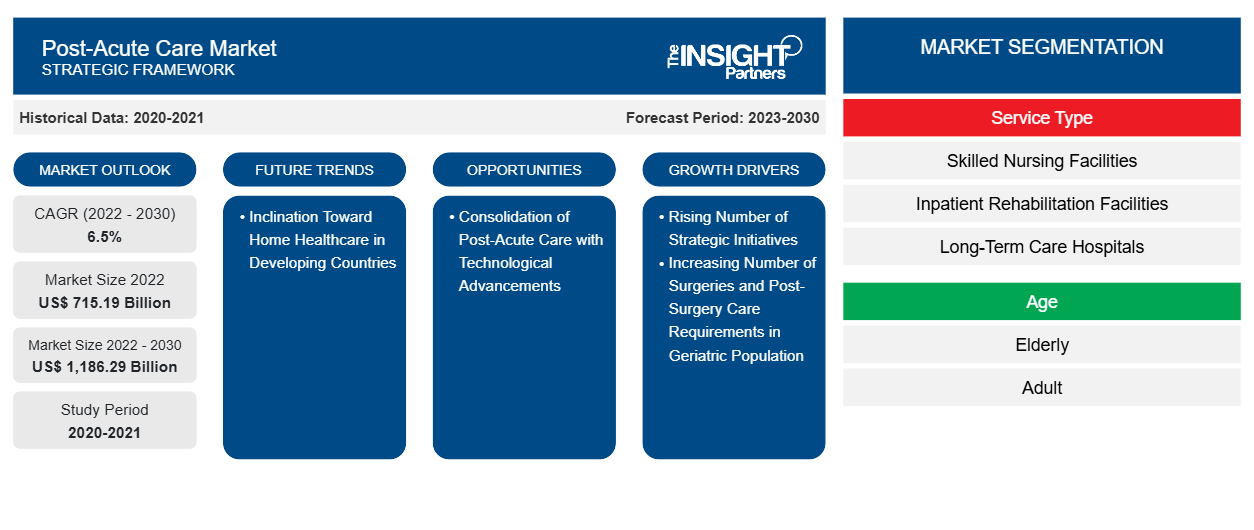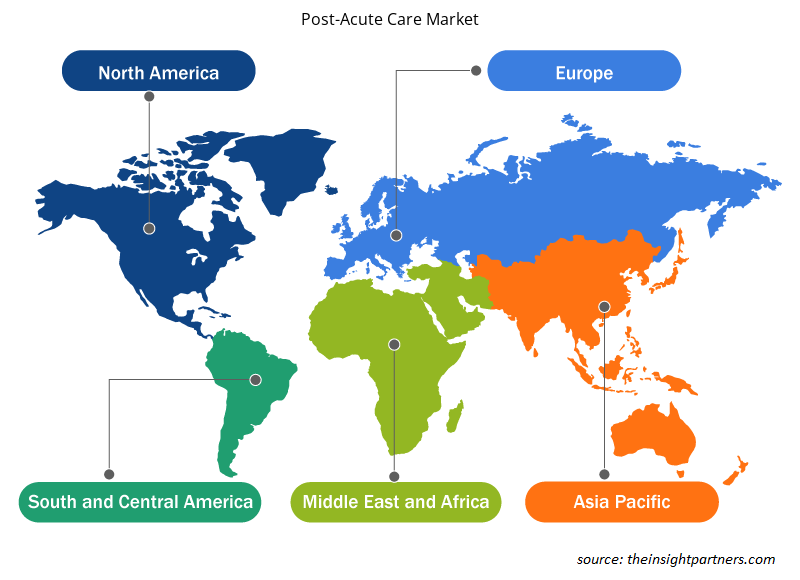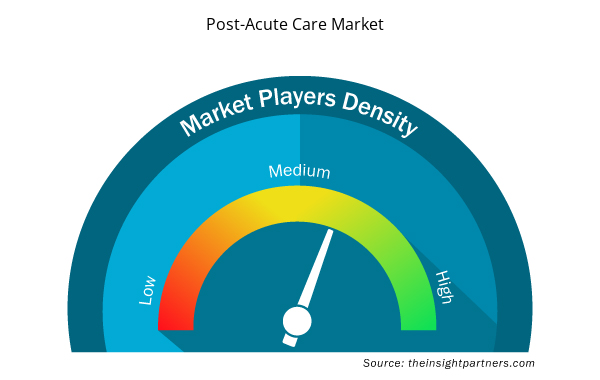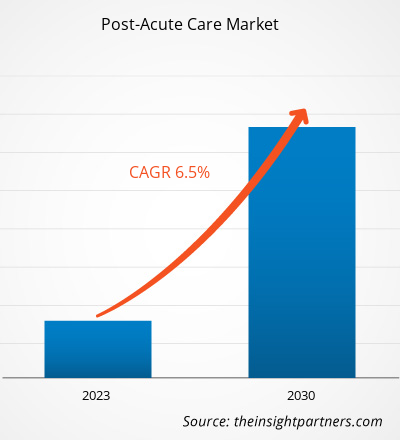[Research Report] The post-acute care market is expected to grow from US$ 715.19 billion in 2022 to US$ 1,186.29 billion by 2030; it is anticipated to record a CAGR of 6.5% from 2022 to 2030.
Market Insights and Analyst View:
The expansion of the post-acute care market size is attributed to the rising cases of chronic diseases, and an increasing number of surgical procedures due to the prevalence of chronic diseases. Post-acute care facilities provide services to patients to achieve their strength and return home. Patients receive these services after hospitalization for injury, illness, or surgery. Post-acute care is sometimes provided as an alternative to acute care hospitalization, depending on the type of disease or injury. It could include a stay in an acute care facility, home health care, or continuous outpatient therapy, based on the seriousness of the disease.
Growth Drivers and Challenges:
Small and big companies operating in the post-acute care market adopt various strategies such as geographic expansion, new product launches, and technological advancements to boost their revenues. A few of the recent developments in the post-acute care market are mentioned below.
- In July 2023, Innovaccer Inc. partnered with Post Acute Analytics (PAA) to help health systems provide patient-centered, value-based care. Using Innovaccer's Best in KLAS data and analytics platform and PAA's integrated point-of-care AI platform as the foundation, healthcare providers can optimize care pathways and aid in the real-time monitoring of patients’ progress throughout the acute and post-acute care continuum.
- In September 2022, Maryland Post-Acute Care Associations and Real Time Medical Systems collaborated with CRISP to connect nursing facilities with a state-designated Health Information Exchange (HIE) program. The innovative program would offer nursing facilities resources and tools to better align with different types of healthcare providers through data transparency to reduce healthcare costs, enhance care, and lower hospital readmissions among the most vulnerable populations.
- In September 2022, the Michigan Health Information Network (MiHIN) partnered with the largest post-acute electronic medical record vendor PointClickCare for its cloud-based software. Under this partnership, they aimed to enable 250 new post-acute providers and case managers to exchange real-time data through the Health Information Exchange (HIE). The MiHIN aims to advance and deepen healthcare collaboration, care coordination, and interoperability by offering access to real-time insights during any stage of treatment.
- In September 2023, Medline partnered with SNF Metrics to offer nursing homes a business intelligence solution with fast and actionable data on risk, accounts receivable, clinical care, staffing, and reimbursement. The company announced an addition to its post-acute care technology solutions portfolio for nursing homes on the back of this partnership.
The active participation of market players in expansions, partnerships, and mergers and acquisitions boosts the growth of the post-acute care market.
Nursing homes and nursing facilities, among other senior care facilities, are stressed with constant understaffing issues. As per an analysis by the US Bureau of Labor Statistics, after March 2020, ~200,000 people lost nursing jobs during the COVID-19 pandemic, which compelled the staff from these facilities to move to jobs that supported their needs. According to a recent survey from the American Health Care Association, many nursing home service providers are experiencing difficulty hiring staff; ~60% of the participating facilities reported that their workforce situation had worsened since January 2022. The same source mentioned that more than 50% of the senior care facilities had to limit their new admissions as they did not have enough staff to provide care for their residents. Moreover, ~55% of the US nursing homes are operating at a financial loss due to staff shortages, with 52% of survey participants admitting that they couldn’t keep the facilities operational open for another year. Thus, challenges associated with this ongoing workforce shortage are expected to intensify in the coming years as healthcare professionals retire or search for other jobs in response to competitive wages, burnout, and new opportunities. Hence, a lack of skilled workforce hampers the growth of the post-acute care market.
Customize This Report To Suit Your Requirement
You will get customization on any report - free of charge - including parts of this report, or country-level analysis, Excel Data pack, as well as avail great offers and discounts for start-ups & universities
Post-Acute Care Market: Strategic Insights

- Get Top Key Market Trends of this report.This FREE sample will include data analysis, ranging from market trends to estimates and forecasts.
Customize This Report To Suit Your Requirement
You will get customization on any report - free of charge - including parts of this report, or country-level analysis, Excel Data pack, as well as avail great offers and discounts for start-ups & universities
Post-Acute Care Market: Strategic Insights

- Get Top Key Market Trends of this report.This FREE sample will include data analysis, ranging from market trends to estimates and forecasts.
Report Segmentation and Scope:
The post-acute care market is divided on the basis of service type, age, disease conditions, and geography. The post-acute care market, by service type, is segmented into skilled nursing facilities, inpatient rehabilitation, long-term care hospitals, home health agencies, and others. The post-acute care market, by age, is segmented into elderly, adults, and others. In 2022, the elderly segment held the largest share of the market. The post-acute care market, by disease condition, is segmented into amputations, wound management, brain and spinal cord injury, neurological diseases, and others. Based on geography, the post-acute care market is segmented into North America (US, Canada, and Mexico), Europe (UK, Germany, France, Italy, Spain, Russia, and Rest of Europe), Asia Pacific (China, Japan, India, South Korea, Australia, Southeast Asia, and Rest of Asia Pacific), the Middle East & Africa (UAE, Saudi Arabia, South Africa, and Rest of Middle East & Africa), and South & Central America (Brazil, Argentina, and Rest of South & Central America).
Segmental Analysis:
The post-acute care market, by service type, is segmented into skilled nursing facilities, inpatient rehabilitation, long-term care hospitals, home health agencies, and others. In 2022, the skilled nursing facilities segment held the largest share of the market. The home health agencies segment is expected to grow at the fastest CAGR during 2022–2030. Skilled nursing facilities (SNFs), which are an essential part of post-acute care, provide custodial and medical care to patients and residents who cannot care for themselves. SNFs provide short-term care focused on helping patients achieve the ability to resume their activities of daily living after an injury, procedure, or illness. Skilled nursing care can be offered in remote locations, depending on the patient’s requirements. Some post-acute care services provided by SNFs include wound care, pain management, medication management, IV therapy, nutritional counseling and support, physical therapy, occupational therapy, speech therapy, and psychotherapy/behavioral health services. Hospitals and skilled nursing facilities collaborate to create patient-focused care plans, which helps them avoid potential readmissions. Home care settings aim to assist individuals with various levels of dependencies to remain at home rather than staying in long-term, residential, or institutional-based nursing care. As per the FSG, INC report published in 2022, the Indian home healthcare (HHC) industry is growing at a notable pace. It is expected to grow at an annual rate of ~19%, in 2022, driven by the increasing geriatric population, lower home care costs than hospitalization, and rising nuclearization of families. Thus, the major advantages of home care settings include cost-effectiveness with excellent clinical outcomes as patients save almost 20–50% of costs compared to regular hospital treatment, depending on the services, by adopting these services.
The post-acute care market, by age, is segmented into elderly, adults, and others. In 2022, the elderly segment held the largest share of the market. The adults segment is expected to grow at the fastest CAGR during 2022–2030. Patients aged 65 years and older tend to have more comorbid chronic diseases and disabilities. These individuals need age-appropriate management to reduce the risk of adverse events during hospitalization. According to the data published in the UptoDate Journal, older adults are more than twice as likely to need hospitalization as adults in middle age, with nearly 17% of Americans aged 65 and more hospitalized at least once a year, while only 8% of adults from the age group of 45–64 required hospitalization. The top diagnoses for admission among older patients include cardiovascular disease and sepsis. Although older patients have the same average length of stay. i.e., 5 days, as adults, they need more support after discharge, perhaps because of functional disability and medical complexity. Nearly 70% of adults of age 65 and above need post-acute care provided by skilled nursing facilities (SNF) or home health service providers, among others, at the time of discharge, compared to 23% of middle-aged (45–64 years old) adults who opt for post-acute care.
The post-acute care market, by disease condition, is segmented into amputations, wound management, brain and spinal cord injury, neurological diseases, and others. In 2022, the neurological disorder segment held the largest share of the market. The market for this segment is expected to grow at the fastest CAGR during 2022–2030.
Regional Analysis:
Based on geography, the post-acute care market is divided into North America, Europe, Asia Pacific, the Middle East & Africa, and South & Central America. North America is the largest contributor to the growth of the global post-acute care market. Asia Pacific is expected to register the highest CAGR in the post-acute care market during 2022–2030. The post-acute care market in the US is primarily driven by the increasing prevalence of chronic diseases, the rising geriatric population, and a growing number of product launches by key players. Aging is a prominent risk factor for chronic diseases, as people above 60 generally have compromised immunity. According to a study published by the Population Reference Bureau in 2020, the population of individuals aged 65 and above was 55 million in the US in 2020, and the number is expected to reach 95 million by 2060. As per the Centers for Disease Control and Prevention (CDC), nearly 735,000 Americans have a heart attack every year, out of which 525,000 patients have had a first heart attack while 210,000 patients have already had a heart attack in the past. According to the US Census Bureau, 2.5 million people in the US over the age of 75 suffer from aortic stenosis, accounting for 12.4% of the population over 75 years of age. An article published in the American Heart Association’s journal mentions mitral regurgitation as the most frequent valve disease in the US. It affects nearly 1 in 10 people of age 75 or above. There is a high demand for post-acute care services in patients with cardiovascular diseases and the geriatric population in the US, driving the market in the country.
Post-acute Care Post-Acute Care Market Regional Insights
The regional trends and factors influencing the Post-Acute Care Market throughout the forecast period have been thoroughly explained by the analysts at Insight Partners. This section also discusses Post-Acute Care Market segments and geography across North America, Europe, Asia Pacific, Middle East and Africa, and South and Central America.

- Get the Regional Specific Data for Post-Acute Care Market
Post-Acute Care Market Report Scope
| Report Attribute | Details |
|---|---|
| Market size in 2022 | US$ 715.19 Billion |
| Market Size by 2030 | US$ 1,186.29 Billion |
| Global CAGR (2022 - 2030) | 6.5% |
| Historical Data | 2020-2021 |
| Forecast period | 2023-2030 |
| Segments Covered |
By Service Type
|
| Regions and Countries Covered | North America
|
| Market leaders and key company profiles |
Post-Acute Care Market Players Density: Understanding Its Impact on Business Dynamics
The Post-Acute Care Market market is growing rapidly, driven by increasing end-user demand due to factors such as evolving consumer preferences, technological advancements, and greater awareness of the product's benefits. As demand rises, businesses are expanding their offerings, innovating to meet consumer needs, and capitalizing on emerging trends, which further fuels market growth.
Market players density refers to the distribution of firms or companies operating within a particular market or industry. It indicates how many competitors (market players) are present in a given market space relative to its size or total market value.
Major Companies operating in the Post-Acute Care Market are:
- Amedisys Inc
- Covenant Care California LLC
- Sonoma Post-Acute
- Victoria Post Acute
- Mission Hills Post Acute Care
Disclaimer: The companies listed above are not ranked in any particular order.

- Get the Post-Acute Care Market top key players overview
Industry Developments and Future Opportunities:
One of the prominent initiative by key players operating in the Post-Acute Care Market are listed below:
- In January 2023, AdventHealth and the University of Chicago Medicine partnered to establish UChicago Medicine AdventHealth. With this, UChicago Medicine bought a controlling stake in AdventHealth's operations in the Great Lakes Region, which includes four Illinois hospitals in Bolingbrook, Glendale Heights, Hinsdale, and La Grange, along with a network of more than 50 physician offices and outpatient facilities.
Competitive Landscape and Key Companies:
A few of the prominent players operating in the post-acute care market are Amedisys Inc, Covenant Care California LLC, Sonoma Post-Acute, Victoria Post Acute, Mission Hills Post Acute Care, Vineyard Post Acute, Brookdale Senior Living Inc, The Alden Network, AdventHealth, and Bella Vista Health Center. These companies focus on new product launches and geographic expansions to meet the growing consumer demand worldwide and increase their product range in specialty portfolios. Their global presence allows them to serve a large base of customers, subsequently facilitating market expansion.
- Historical Analysis (2 Years), Base Year, Forecast (7 Years) with CAGR
- PEST and SWOT Analysis
- Market Size Value / Volume - Global, Regional, Country
- Industry and Competitive Landscape
- Excel Dataset


- Clinical Trial Supplies Market
- Ceiling Fans Market
- Airline Ancillary Services Market
- Travel Vaccines Market
- Quantitative Structure-Activity Relationship (QSAR) Market
- Airport Runway FOD Detection Systems Market
- Artificial Intelligence in Defense Market
- Public Key Infrastructure Market
- Sexual Wellness Market
- Bio-Based Ethylene Market

Report Coverage
Revenue forecast, Company Analysis, Industry landscape, Growth factors, and Trends

Segment Covered
Service Type, Age, Disease Conditions, and Geography

Regional Scope
North America, Europe, Asia Pacific, Middle East & Africa, South & Central America

Country Scope
This text is related
to country scope.
Frequently Asked Questions
Post-acute care facilities provide services to patients to achieve their strength and return home. Patients receive these services after hospitalization for injury, illness, or surgery. In response, hospitals have started developing strategic partnerships with post-acute care facilities. Post-acute care encompasses a broad range of services the patient gets after hospitalization. Sometimes, these services are provided as an alternative to acute care hospitalization, depending upon the type of disease or injury. It could include a stay in an acute care facility, home health care, or continuous outpatient therapy. It all depends upon the seriousness of the disease.
The factors driving the market include rising number of strategic initiatives and increasing number of surgeries and post-surgery care requirements in geriatric population. However, lack skilled workforce hinders the market growth.
The post-acute care market majorly consists of the players such Amedisys Inc, Covenant Care California LLC, Sonoma Post-Acute, Victoria Post Acute, Mission Hills Post Acute Care, Vineyard Post Acute, Brookdale Senior Living Inc, The Alden Network, AdventHealth, and Bella Vista Health Center.
The post-acute care market, by service type, is segmented into skilled nursing facilities, inpatient rehabilitation, long-term care hospitals, home health agencies, and others. In 2022, the skilled nursing facilities segment held the largest share of the market. However, home health agencies segment is expected to grow at the fastest CAGR during 2022–2030.
The post-acute care market, by age, is segment into elderly, adults, and others. In 2022, the elderly segment held the largest share of the market. However, the adult segment is expected to grow at the fastest CAGR during 2022–2030.
The post-acute care market, by disease conditions, is segment into amputations, wound management, brain and spinal cord injury, neurological diseases, and others. In 2022, the neurological disorder segment held the largest share of the market. Moreover, same segment is expected to grow at the fastest CAGR during 2022–2030.
Based on geography, the post-acute care market is segmented into North America (the US, Canada, and Mexico), Europe (the UK, Germany, France, Italy, Spain, and the Rest of Europe), Asia Pacific (China, Japan, India, South Korea, Australia, and the Rest of Asia Pacific), the Middle East & Africa (the UAE, Saudi Arabia, South Africa, and Rest of the Middle East & Africa), and South & Central America (Brazil, Argentina, and the Rest of South & Central America). North America is the largest contributor to the growth of the global post-acute care market. Asia Pacific is expected to register the highest CAGR in the post-acute care market during 2022–2030.
Trends and growth analysis reports related to Life Sciences : READ MORE..
The List of Companies - Post-Acute Care Market
- Amedisys Inc
- Covenant Care California LLC
- Sonoma Post-Acute
- Victoria Post Acute
- Mission Hills Post Acute Care
- Vineyard Post Acute
- Brookdale Senior Living Inc
- The Alden Network
- AdventHealth
- Bella Vista Health Center

 Get Free Sample For
Get Free Sample For